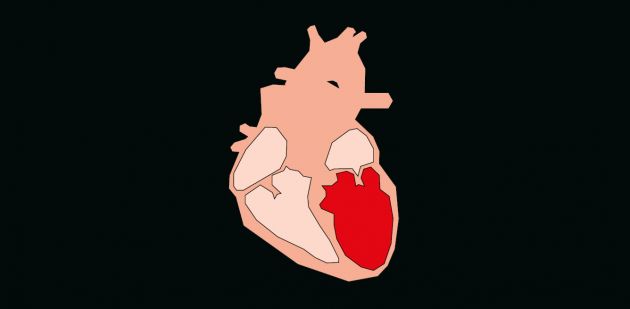Intense emotions can lead to a serious heart condition that looks like a heart attack and mainly affects women: broken heart syndrome.

The Sunday service did not go as planned for Simone Vaucher, 78, a retired teacher. Next to her on the pew, a woman swayed a bit then collapsed. The former teacher, horrified, thought the woman was dead. Eventually, the woman seemed to recover from her fainting spell, but Simone Vaucher remained distraught. “Once I got home, it took me three hours to settle down. My heart was pounding and it hurt to breathe. I didn’t know whether it was my lungs or my heart,” she says. Unable to get over it, she went to see her general practitioner, who sent her to the emergency room at Lausanne University Hospital (CHUV), suspecting that she had had a heart attack. But the investigations came up with another cause. She had takotsubo cardiomyopathy, or broken heart syndrome.
Takotsubo cardiomyopathy is a heart condition often triggered by emotional stress. Cardiologists do not know how to prevent it, as the syndrome is not yet fully understood. However, catecholamines, or stress hormones, have been shown to spike with the onset of this condition. The result is that the contraction of the heart muscle is weakened at the apex, which prevents the organ from functioning properly. Part of the heart balloons into the characteristic shape of a large jar or amphora.
“The trigger may be emotional or physical stress,” says Sarah Hugelshofer, cardiologist with the CHUV’s Cardiology Service. Most emotional cases occur after a sudden shock, such as news of a death, but also in happy situations, like winning the lottery. Half of all cases involve physical stress and are triggered by intense physical activity that the person is unprepared for, severe pain or neurological conditions, such as or epileptic seizures. A history of psychiatric disorders such as anxiety and depression increase a person’s predisposition to the syndrome. Hereditary factors probably play a role, as several cases can exist in some families.
It affects a ratio of nine women to one man. Takotsubo cardiomyopathy is more prevalent in women as they approach menopause, suggesting a link with the decline in oestrogen levels. “These hormones are known for their role in protecting against cardiovascular disease, but their connection with the syndrome is not clearly understood, nor are the factors that determine the course of the disease,” the cardiologist explains.
The symptoms, however, are more familiar, resembling those of a heart attack: chest pain, shortness of breath and fainting. Unfortunately, they cannot be immediately distinguished because “the initial electrocardiograms look the same, as do the cardiac blood markers,” Sarah Hugelshofer says. However, a coronary angiography can accurately diagnose whether the event is in fact a myocardial infarction. Any partial or complete obstruction in the coronary arteries, which can cause a heart attack, will show up using this invasive X-ray imaging technique. “If there is no visible occlusion, we look for something else, such as myocardial inflammation or takotsubo. An ultrasound and often an MRI of the heart are then performed to determine the final diagnosis.”
As the arterial occlusion triggering the heart attack causes heart muscle cells to die and, in severe cases, leads to death of the patient, blood flow must urgently be restored. With broken heart syndrome, hospitalisation, cardiac monitoring and medication are needed. “It is therefore crucial to distinguish between the two conditions using coronary imaging,” the cardiologist explains.
A research team from ETH Zurich and the University of Zurich has recently designed a tool that uses artificial intelligence to help differentiate takotsubo cardiomyopathy from myocardial infarction. “Usually, this is done using coronary angiography, but we wanted to test how well an ultrasound could deliver a diagnosis.
First, we trained our AI system with echocardiography data from individuals with a known diagnosis, so that it could automatically learn to identify and extract information relevant for diagnosis. We then tested it on other data and compared it to humans,” says Fabian Laumer, a doctoral student in the Department of Computer Science at ETH Zurich and first author of the study. The system was found to be faster and slightly more efficient than cardiologists. “But it is still a long way from achieving the accuracy of a coronary angiography,” the researcher says.
Artificial intelligence is already used in cardiology to measure cardiac function in addition to manual analyses, especially for MRI imaging. “Although it can’t replace humans, it can be more reliable in some cases, because a computer applies an analysis that can be reproduced in exact detail, unlike human operators,” Sarah Hugelshofer adds. /
Takotsubo cardiomyopathy mainly affects women, and little is understood about the condition in a medical world made by men for men. Even today, women die twice as often as men from cardiovascular disease, including takotsubo, because women are under-represented in the clinical studies on which patient care protocols and treatment tests are defined. The result is a gender gap in cardiology, in which women are still too often not treated as well as men.